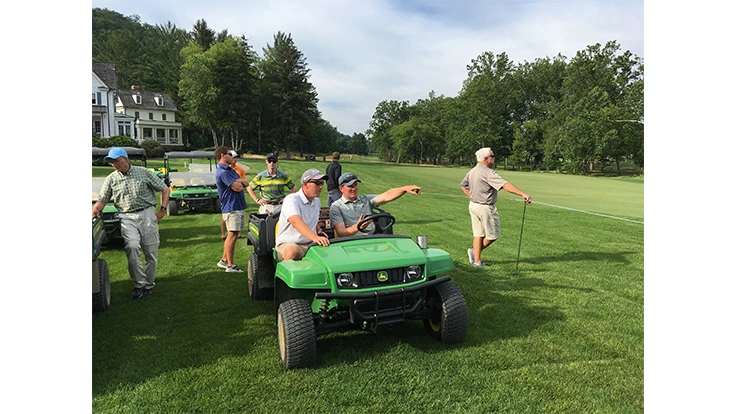
Turf volunteers converging in southern West Virginia are receiving a firsthand glimpse at the challenges The Greenbrier agronomic team faced during the past year.
An eager group of 25 workers representing all segments of the industry arrived in southern West Virginia, Wa., earlier this week to assist an exhausted crew in preparing The Old White TPC for the first Greenbrier Classic since last summer’s historic flood. Volunteers quickly discovered upon their arrival the magnitude of the flood as assistant superintendents Chris Anderson and Greg Caldwell started a tour of the course at the 15th hole, a par 3 parallel to Howard’s Creek. The hole was submerged as 11 inches of rain battered the area June 23, 2016.
“I just can’t imagine that kind of devastation, so sudden and so dramatic,” says Burr Betts, the superintendent at Buffalo Peak Golf Course Union, Ore. “I can’t imagine water being that high that fast.”
Betts, a retired biology professor at Eastern Oregon University turned municipal course superintendent, traveled for nearly 24 straight hours and made two connecting flights before arriving at The Greenbrier Sunday, July 2. The Greenbrier Classic represented his first PGA Tour volunteer experience. He received the bulk of his turf training working summers at Buffalo Peak, and he’s in his fourth year as an unexpected second career as a superintendent. “When I saw the call for volunteers, I thought this was an opportunity to work with people that are maybe a little more current and learn some things that might be applicable for our course,” Betts says.
Horry Georgetown professor Ashley Wilkinson is a veteran tournament volunteer, having worked worldwide events such as the Masters and The Players Championship. Two of his former students, Carrington and Nate Bryant, are superintendents of the resort’s Meadows and Greenbrier courses, and two of his current students, Robert Carlyle and Colin Shannon, are summer interns at the resort. Carrington and Nate played major roles in the rebuilding of the Meadows course.
“I wanted to see how do you put three places back together in a half-a-year,” Wilkinson says. “You get no winter to do it. If I’m in Florida, I’m growing. But here you basically get two shoulder seasons to put three courses back together and try to sustain a PGA Tour event. To come up and see it with my own eyes and to see my graduates and how they are doing and how my interns are doing, was sort of a can’t-miss opportunity for me.”
David Callahan describes participating in the first post-flood Greenbrier Classic as a “special” experience. Callahan spent 15 years as an assistant and head superintendent in Virginia before moving into a sales role with Growth Enhancer Turf Consultants earlier this year. Volunteering at a PGA Tour stop was one of Callahan’s career desires, but he never felt comfortable straying from his course. The week has provided numerous humbling and uplifting moments.
“I can’t imagine something so gut-wrenching, he says. “You pour so much time and effort into your job and your work and you take so much pride in it, and then to have something like that happen … For most people and most professions, it would be demoralizing. But I think superintendents are an especially rare breed.
“We deal day in and day out with the unexpected and plans change on a dime. Mother Nature does it, greens committees do it. It’s always evolving and to some extent you are always reacting. But I can’t imagine what these guys went through and what they have gone through to get this place to where it is. It’s pretty spectacular.”
Numerous morning and evening assignments are placing volunteers alongside full-time crew members who experienced significant personal losses last summer. The quick bonds established are noticeable as the groups simultaneously hustle to execute tasks such as raking bunkers, filling divots and removing water from fairways. The coordinated effort has turned The Old White TPC into a tournament-ready course less than a year after constructed commenced.
“Monday when I saw that tent full getting more and more volunteers, you knew they were here to help us,” director of golf course maintenance operations Kelly Shumate says. “It’s almost a sense of relief – your backups are coming and we are going to help you get through the finish line. That’s what’s so special about our industry.”
Guy Cipriano is GCI’s associate editor.
An eager group of 25 workers representing all segments of the industry arrived in southern West Virginia, Wa., earlier this week to assist an exhausted crew in preparing The Old White TPC for the first Greenbrier Classic since last summer’s historic flood. Volunteers quickly discovered upon their arrival the magnitude of the flood as assistant superintendents Chris Anderson and Greg Caldwell started a tour of the course at the 15th hole, a par 3 parallel to Howard’s Creek. The hole was submerged as 11 inches of rain battered the area June 23, 2016.
“I just can’t imagine that kind of devastation, so sudden and so dramatic,” says Burr Betts, the superintendent at Buffalo Peak Golf Course Union, Ore. “I can’t imagine water being that high that fast.”
Betts, a retired biology professor at Eastern Oregon University turned municipal course superintendent, traveled for nearly 24 straight hours and made two connecting flights before arriving at The Greenbrier Sunday, July 2. The Greenbrier Classic represented his first PGA Tour volunteer experience. He received the bulk of his turf training working summers at Buffalo Peak, and he’s in his fourth year as an unexpected second career as a superintendent. “When I saw the call for volunteers, I thought this was an opportunity to work with people that are maybe a little more current and learn some things that might be applicable for our course,” Betts says.
Horry Georgetown professor Ashley Wilkinson is a veteran tournament volunteer, having worked worldwide events such as the Masters and The Players Championship. Two of his former students, Carrington and Nate Bryant, are superintendents of the resort’s Meadows and Greenbrier courses, and two of his current students, Robert Carlyle and Colin Shannon, are summer interns at the resort. Carrington and Nate played major roles in the rebuilding of the Meadows course.
“I wanted to see how do you put three places back together in a half-a-year,” Wilkinson says. “You get no winter to do it. If I’m in Florida, I’m growing. But here you basically get two shoulder seasons to put three courses back together and try to sustain a PGA Tour event. To come up and see it with my own eyes and to see my graduates and how they are doing and how my interns are doing, was sort of a can’t-miss opportunity for me.”
David Callahan describes participating in the first post-flood Greenbrier Classic as a “special” experience. Callahan spent 15 years as an assistant and head superintendent in Virginia before moving into a sales role with Growth Enhancer Turf Consultants earlier this year. Volunteering at a PGA Tour stop was one of Callahan’s career desires, but he never felt comfortable straying from his course. The week has provided numerous humbling and uplifting moments.
“I can’t imagine something so gut-wrenching, he says. “You pour so much time and effort into your job and your work and you take so much pride in it, and then to have something like that happen … For most people and most professions, it would be demoralizing. But I think superintendents are an especially rare breed.
“We deal day in and day out with the unexpected and plans change on a dime. Mother Nature does it, greens committees do it. It’s always evolving and to some extent you are always reacting. But I can’t imagine what these guys went through and what they have gone through to get this place to where it is. It’s pretty spectacular.”
Numerous morning and evening assignments are placing volunteers alongside full-time crew members who experienced significant personal losses last summer. The quick bonds established are noticeable as the groups simultaneously hustle to execute tasks such as raking bunkers, filling divots and removing water from fairways. The coordinated effort has turned The Old White TPC into a tournament-ready course less than a year after constructed commenced.
“Monday when I saw that tent full getting more and more volunteers, you knew they were here to help us,” director of golf course maintenance operations Kelly Shumate says. “It’s almost a sense of relief – your backups are coming and we are going to help you get through the finish line. That’s what’s so special about our industry.”
Guy Cipriano is GCI’s associate editor.
Latest from Golf Course Industry
- Seeking sustainability in Vietnam
- Kerns featured in Envu root diseases webinar
- Toro continues support of National Mayor’s Challenge for Water Conservation
- A different kind of long distance
- Golf Construction Conversations: Stephen Hope
- EnP welcomes new sales manager
- DLF opening centers in Oregon, Ontario
- Buffalo Turbine unveils battery-powered debris blower





